Differential Structure of Inductive Proximity Sensor
Abstract
:1. Introduction
2. Structure of Sensor Characteristics
3. Analysis of Sensor Characteristics
4. Algorithm Implementation of the Differential Structure
- The same source is chosen for the ADC and the step input module to offset the inconsistence between the ADC reference and step input sources. The sample value of the ADC reflects the proportion of the response waveform in the high level of step input directly. Thus, the demands for power design decrease, and the calibration procedure is simplified. However, the proportion of variations in the single-sensing-coil structured response with distance in a high level of step input is limited.
- The distance measurement range of 0–1.0 mm is generally undetected quantitatively because of the mechanical manufacturing deviation. The distance measurement range of 1.0–5.0 mm is the major detection range. However, a nonlinear relationship exists between the sensitivity of the sensing coil and distance (Figure 6). The detection sensitivity in the secondary range of small distance is relatively high, whereas the detection sensitivity in the primary detection range of large distance is relatively low.
4.1. Linear Interpolation and Reduction in Dimension
- The inductance components of two sensing coils are changed consistently with the distance.
- The resistance components of two sensing coils present similar variation with the environmental temperature.
- The differential structured response has one and only one inflection point, which is a monotone function after the inflection point. This characteristic is similar to that of the single-sensing-coil structured response.
- The differential structured IPS is composed of two single-sensing-coil structured IPSs, which are linear time-invariant (LTI) systems. The differential structured IPS composed by the two single-sensing-coil structured IPSs is also an LTI system.
4.2. Online Computation Flow
- Apply step input on the nearby and distant sensing coils.
- Acquire real-time sample vector (Sd1, Sd2) at two fixed delay moments.
- Substitute Sd2 into Equation (17) for 61 iterations of a multiply–add operation to obtain the temporary look-up table (Sd1T_i).
- Compare Sd1 in the temporary look-up table bottom-up, and stop the search when Sd1 is higher than data (Sd1T_i) in the temporary look-up table.
- The integral part of the measured distance is the sum of calibrated step lengths for searching (and adding the starting point of calibration), which corresponds to x × 0.1 mm in the table.
5. Results and Discussion
- The responses of two symmetric circuits are differenced and amplified by the INA, and the proportion of the variation in the dynamic range of ADC of the differential response increases significantly. The proportion of the variation increases from 8.3% to 75% compared with that of single-sensing-coil structured method, thereby realizing full use of the conversion ability of the high-accuracy ADC and increasing the sensitivity and resolution of the distance measurement.
- The dimension of the two-dimensional look-up table decreases through the linear approximation based on the approximate linear distribution of the sampling vector and environmental temperature. This method solves the large-scaled look-up table problems brought by the high-accuracy ADC and decreases the consumption of storage and searching resources as follows:
- The second sampling moment is set to “infinite”, and the constraint relationships of sampling vectors over distance and temperature are separated. The two-dimensional constraints are simplified as constraints over the sample value (Sd1) and distance under different temperatures. The two-dimensional look-up table can be recorded as a group of one-dimensional look-up tables.
- The relationship between the sample value (Sd1) and temperature is approximately linear. The number of one-dimensional look-up tables can be decreased to two. In addition, the relationships between the sample value (Sd1) and the distance under two calibration temperatures are set up by calibration. Specifically, the corresponding one-dimensional look-up tables under any temperature can be obtained from the two calibration tables through the interpolation algorithm while meeting the error conditions.
- The increase in interpolation error is offset by the distribution of the measurement sensitivity, and the distance error decreases. At −55 °C and 7.0 mm, the maximum distance error of the differential structured IPS is decreased to 3.3% of that of the single-sensing-coil structured IPS. The practical value improves significantly.
- The differential amplifier structure inhibits the common-mode signal, offsets influences of external electromagnetic interference on the symmetric response circuits effectively, and improves the electromagnetic compatibility of the IPS. The temperature effects on the symmetric response circuits of nearby and distant sensing coils are also weakened in the same environment.
- The differential structured and dimension-reduced IPS method reduces storage, searching consumption and online computation complexity, and saves the use of process control components. The numerical decoupling calculation separates the resistance and inductance components of the IPS sensing coils and improves the temperature adaptation of IPS.
6. Conclusions
7. Patents
- Shao Zhibiao, Guo Yixin. Aviation-specific displacement sensor measuring method: CN, ZL201210078266.9[E]. 02 Apr 2014. (authorized)
- Shao Zhibiao, Guo Yixin. Measurement method for aviation-specific displacement sensor: US(PCT), US2015051857-A1[E]. 22 Sep 2014.
- Shao Zhibiao, Guo Yixin. Data processing method of inductive type displacement sensor: CN, ZL201610278608.X[E]. 17 Jul 2018. (authorized)
- Shao Zhibiao, Guo Yixin. Interference elimination method for inductance type displacement sensor: CN, ZL201710115059.9[E]. 31 May 2017. (authorized)
Author Contributions
Funding
Conflicts of Interest
References
- Hoai, N.; Thanh, N.L.C. Improve Static Performance Identification of Inductive Proximity Sensor for a Mobile Robot. In Proceedings of the MATEC Web of Conferences, Hong Kong, China, 28–30 April 2016; p. 05005. [Google Scholar]
- Hagan, M. Inductive proximity sensors network in intelligent clothes. In Proceedings of the 2017 E-Health and Bioengineering Conference (EHB), Sinaia, Romania, 22–24 June 2017; pp. 225–228. [Google Scholar]
- Gorczewska, A.; Polinski, A.; Wtorek, J.; Truyen, B. A novel concept for tissue-metal detection and differentiation using an inductive proximity sensor. In Proceedings of the IOP Conference Series: Materials Science and Engineering, Bristol, Britain, 19–24 August 2016; p. 012037. [Google Scholar]
- Jiao, J.P.; Li, L.; Wu, B.; He, C.F. Novel capacitive proximity sensors for assessing the aging of composite insulators. Sens. Actuators A Phys. 2017, 253, 75–84. [Google Scholar] [CrossRef]
- Kwang-Hee, L.; Jong-Hyun, L.; Ki-Bum, S.; Suk-Han, Y. Performance Evaluation of Wheel Detection Sensor Using an Inductive Proximity Sensor for The High Speed Railway. Trans. Korean Inst. Electr. Eng. 2016, 65, 895–901. [Google Scholar]
- Sakthivel, M.; George, B.; Sivaprakasam, M. A New Inductive Proximity Sensor Based Guiding Tool to Locate Metal Shrapnel During Surgery. IEEE Trans. Instrum. Meas. 2014, 63, 2940–2949. [Google Scholar] [CrossRef]
- Hong, Y.; Kim, S.G.; Kim, B.H.; Ha, S.J. Noncontact Proximity Vital Sign Sensor Based on PLL for Sensitivity Enhancement. IEEE Trans. Biomed. Circ. Syst. 2014, 8, 584–593. [Google Scholar] [CrossRef] [PubMed]
- Rajaram, S. Global Markets and Technologies for Sensors: Focus on Position Sensors; BCC Research: Wellesley, MA, USA, 2013; pp. 354–355. [Google Scholar]
- Kim, Y.; Choi, H.Y.; Lee, Y.C. Design and Preliminary Evaluation of High-Temperature Position Sensors for Aerospace Applications. IEEE Sens. J. 2014, 14, 4018–4025. [Google Scholar] [CrossRef]
- Jagiella, M.; Fericean, S.; Dorneich, A. Progress and recent realizations of miniaturized inductive proximity sensors for automation. IEEE Sens. J. 2006, 6, 1734–1741. [Google Scholar] [CrossRef]
- Masi, A.; Danisi, A.; Losito, R.; Perriard, Y. Characterization of Magnetic Immunity of an Ironless Inductive Position Sensor. IEEE Sens. J. 2013, 13, 941–948. [Google Scholar] [CrossRef]
- Danisi, A.; Masi, A.; Losito, R.; Perriard, Y. Modeling and Compensation of Thermal Effects on an Ironless Inductive Position Sensor. IEEE Trans. Ind. Appl. 2014, 50, 375–382. [Google Scholar] [CrossRef]
- Cooper, S. Position Sensors Market Analysis, Market Size, Application Analysis, Regional Outlook, Competitive Strategies and Forecasts, 2016 to 2024; Hexa Research: Felton, CA, USA, 2014; pp. 1211–1222. [Google Scholar]
- Fleming, A.J. A review of nanometer resolution position sensors: Operation and performance. Sens. Actuators A Phys. 2013, 190, 106–126. [Google Scholar] [CrossRef]
- Ceschini, L. Anatomy of an A380. Fortune 2007, 155, 101–122. [Google Scholar]
- Ossmann, D.; Joos, H.D.; Goupil, P. Enhanced Sensor Monitoring to Maintain Optimal Aircraft Handling in Case of Faults. J. Guidance Control Dyn. 2017, 40, 3127–3137. [Google Scholar] [CrossRef]
- Arthasartsri, S.; Ren, H. Validation and verification methodologies in A380 aircraft reliability program. In Proceedings of the 2009 8th International Conference on Reliability, Maintainability and Safety, Chengdu, China, 20–24 July 2009; pp. 1356–1363. [Google Scholar]
- Podhraski, M.; Trontelj, J. A Differential Monolithically Integrated Inductive Linear Displacement Measurement Microsystem. Sensors 2016, 16, 384. [Google Scholar] [CrossRef]
- Zhao, J. Rigorous theoretical derivation of lumped models to transmission line systems. J. Semicond. 2012, 33, 035008–035015. [Google Scholar] [CrossRef]
- Sun, N.; Tan, M.; Li, P.; Jiao, J.; Guo, X.; Guo, W. Long-term storage life of light source modules by temperature cycling accelerated life test. J. Semicond. 2014, 35, 054010–054015. [Google Scholar] [CrossRef]
- Alcorta-Garcia, E.; Zolghadri, A.; Goupil, P. A Nonlinear Observer-Based Strategy for Aircraft Oscillatory Failure Detection: A380 Case Study. IEEE Trans. Aerospace Electron. Syst. 2011, 47, 2792–2806. [Google Scholar] [CrossRef]
- Wei, W. Research on High-quality Dual-Redundancy Aircraft Rudder Servo System Simulation. Appl. Mech. Mater. 2014, 519–520, 1345–1350. [Google Scholar]
- Cai, J.; Li, X.; Chen, X. Joint optimization of maintenance inspection and spare provisioning for aircraft deteriorating parts. J. Syst. Eng. Electron. 2017, 28, 1133–1140. [Google Scholar]
- Society of Automotive Engineers (SAE). AIR 1810–2003, Design, Development and Test Criteria—Solid State Proximity Switches/Systems for Landing Gear Applications; Society of Automotive Engineers (SAE): Pennsylvania, PA, USA, 2003; pp. 370–381. [Google Scholar]
- Radio Technical Commission for Aeronautics (RTCA). RTCA/DO-160 F, Environmental Conditions and Test Procedures for Airborne Equipment; Radio Technical Commission for Aeronautics (RTCA): Washington, DC, USA, 2007; pp. 158–180. [Google Scholar]
- Ao, L.Z.; Miao, Y. Feasibility Investigation on Reduced-Power Take-off of MA600. Adv. Mater. Res. 2013, 779, 486–490. [Google Scholar] [CrossRef]
- Mizuno, T.; Fujii, T.; Mizuguchi, T.; Kishi, Y.; Nakaya, K.; Kasai, M.; Shimizu, A. Inductive Proximity Sensor with Novel Structure of Ferrite Core. Mater. Sci. Forum 2011, 670, 142–150. [Google Scholar] [CrossRef]
- Gonçalves, F.C.C.; Trabasso, L.G. Aircraft Preventive Maintenance Data Evaluation Applied in Integrated Product Development Process. J. Aerospace Technol. Manag. 2018, 10, 1718–1723. [Google Scholar] [CrossRef]
- Guo, Y.X.; Shao, Z.B.; Li, T. An Analog-Digital Mixed Measurement Method of Inductive Proximity Sensor. Sensors 2016, 16, 18. [Google Scholar] [CrossRef] [PubMed]
- Zhang, X.; Liu, X.; Dong, Q. Take-off and landing adaptability of A380-800 large aircraft on existing pavement. J. Beijing Univ. Aeronaut. Astronaut. 2016, 42, 1812–1818. [Google Scholar]
- Modal, K.R. Analysis of Goodrich Landing Gear for the A380. Sound Vib. 2008, 42, 6–7. [Google Scholar]
- Schafer, L.; Garcia, S.; Mitschke, A.; Srithammavanh, V. Redundancy system design for an aircraft door management system. Comput. Oper. Res. 2018, 94, 11–22. [Google Scholar] [CrossRef]
- Zhu, Y.; Wang, B.; An, G.; Gao, Y. Design and simulation of automatic protection control law for large aircraft flaps and slats. Flight Dyn. 2015, 33, 324–327. [Google Scholar]
- Jianqi, A.; Liqing, L.; Jianliang, L.; Yuhua, L.; Song, W. A novel dual-redundancy anti-skid braking system with crossing management method in aircraft. In Proceedings of the 2009 7th Asian Control Conference (ASCC 2009), Shanghai, China, 27–29 August 2009; pp. 1138–1142. [Google Scholar]
- Danisi, A.; Masi, A.; Losito, R.; Perriard, Y. Modeling of High-Frequency Electromagnetic Effects on an Ironless Inductive Position Sensor. IEEE Sens. J. 2013, 13, 4663–4670. [Google Scholar] [CrossRef]
- Crane Aerospace & Electronics, Inc. Proximity Sensing Systems Overview. Available online: http://www.craneae.com/Products/Sensing/ProximitySystemsOverview.aspx (accessed on 1 November. 2018).
- Crouzet, Inc. Switches and Position Sensors—Aerospace. Available online: http://www.crouzet-aerospace.com/product-lines/detection-and-sensing (accessed on 1 November. 2018).
- Yu, D.; Zheng, Q.; Cui, J.; Jiao, J.; Guo, X.; Guo, W. Total dose responses and reliability issues of 65 nm NMOSFETs. J. Semicond. 2016, 37, 129–135. [Google Scholar]
- Honeywell International, Inc. Proximity Sensors—Honeywell [EB/OL]. Available online: http://sensing.honeywell.com/products/aero-prox4?N=0 (accessed on 1 November 2018).
- Leons, P. A Proximity Measurement System on FPGA for Avionic Applications. Masters’s Thesis, Concordia University, Montreal, QC, Canada, 2015. [Google Scholar]
- Huang, W.; Wang, C.; Liu, L.; Huang, X.; Wang, G. A signal conditioner IC for inductive proximity sensors. In Proceedings of the 2011 IEEE 9th International Conference on ASIC, Xiamen, China, 25–28 October 2011; pp. 141–144. [Google Scholar]
- Kazi, I.; Meinerzhagen, P.; Gaillardon, P.E. Energy/Reliability Trade-Offs in Low-Voltage ReRAM-Based Non-Volatile Flip-Flop Design. IEEE Trans. Circuits Syst. Regul. Pap. 2014, 61, 3155–3164. [Google Scholar] [CrossRef]
- Xie, C.; Wang, Z.; Wu, L.; Liu, Y. A Novel high Reliability CMOS SRAM Cell. J. Semicond. 2011, 32, 075011–075015. [Google Scholar] [CrossRef]
- Lins, F.M.; Tambara, L.A.; Kastensmidt, F.L.; Rech, P. Register File Criticality and Compiler Optimization Effects on Embedded Microprocessor Reliability. IEEE Trans. Nuclear Sci. 2017, 64, 2179–2187. [Google Scholar] [CrossRef]
- Ustaoglu, B.; Yalcin, B.O. Ieee. Reliability Analysis of MIPS-32 Microprocessor Register Files Designed with Different Fault Tolerant Techniques. In Proceedings of the 2016 24th Signal Processing and Communication Application Conference (SIU), Zonguldak, Turkey, 16–19 May 2016; pp. 2073–2076. [Google Scholar]
- Gong, C.; Zhou, W. Improvement of equivalent component approach for reliability analyses of series systems. Struct. Saf. 2017, 68, 65–72. [Google Scholar] [CrossRef]
- Wang, G.J.; Duan, F.J.; Zhou, Y.F. Reliability evaluation of multi-state series systems with performance sharing. Reliab. Eng. Syst. Saf. 2018, 173, 58–63. [Google Scholar] [CrossRef]
- Jahanirad, H. Reliability Model for Multiple-Error Protected Static Memories. J. Electron. Test. Theory Appl. 2017, 33, 189–207. [Google Scholar] [CrossRef]
- Harvey, D.; van der Hoeven, J. On the complexity of integer matrix multiplication. J. Symbol. Comput. 2018, 89, 1–8. [Google Scholar] [CrossRef]
- Wang, D.W.; Wang, W.; Feng, Z.Y. Dynamic assessment model for MTBF of aero-engine based on fuzzy integral. J. Aerospace Power 2013, 28, 983–988. [Google Scholar]
- Yin, M.L.; Angus, J.; Arellano, R. Allocating Redundancy with Reusable Patterns for Optimal Hierarchical-System Reliability and Series MTBF. In Proceedings of the Annual Reliability and Maintainability Symposium, Lake Buena Vista, FL, USA, 27–29 January 2011; pp. 3581–3593. [Google Scholar]
- Armstrong, K. The new IET Guide—How to Do EMC to Help Achieve Functional Safety; Springer: London, UK, 2010; pp. 509–514. [Google Scholar]
- Cai, J.; Deng, Z.Q. Switched-Reluctance Position Sensor. IEEE Trans. Magn. 2014, 50, 1–4. [Google Scholar] [CrossRef]
- John, R.B. Reluctance Method; Wiley-IEEE Press: New York City, NY, USA, 2014; pp. 395–399. [Google Scholar]
- Liu, S.; Shan, G.B.; Xie, C.M.; Du, X.R. A transmission line-type electrical model for tapered TSV considering MOS effect and frequency-dependent behavior. J. Semicond. 2015, 36, 92–98. [Google Scholar] [CrossRef]
- Guo, Y.X.; Shao, Z.B.; Tao, H.B.; Xu, K.L. Dimension-Reduced Analog-Digital Mixed Measurement Method of Inductive Proximity Sensor. Sensors 2017, 17, 1533. [Google Scholar] [CrossRef]
- Patiluna, V.B.; Canete, L.G.S.; Maja, J.M. Development of an obstacle detection system using ultrasonic proximity sensors. Inf. Technol. Intell. Control Bioprod. Syst. 2006, 5, 143–147. [Google Scholar]
- Kumar, P.; George, B.; Kumar, V.J. A Simple Signal Conditioning Scheme for Inductive Sensors. In Proceedings of the 2013 Seventh International Conference on Sensing Technology (ICST), Wellington, New Zealand, 3–5 December 2013; pp. 512–515. [Google Scholar]
- KrüGer, H.; Ewald, H.; Frost, A. Multivariate data analysis for accuracy enhancement at the example of an inductive proximity sensor. In Proceedings of the 2009 IEEE SENSORS, Christchurch, New Zealand, 25–28 October 2009; pp. 759–763. [Google Scholar]
- Chen, S.C.; Le, D.K.; Nguyen, V.S. Inductive Displacement Sensors with a Notch Filter for an Active Magnetic Bearing System. Sensors 2014, 14, 12640–12657. [Google Scholar] [CrossRef]
- Fericean, S.; Droxler, R. New noncontacting inductive analog proximity and inductive linear displacement sensors for industrial automation. IEEE Sens. J. 2007, 7, 1538–1545. [Google Scholar] [CrossRef]
- Mizuno, T.; Enoki, S.; Hayashi, T.; Asahina, T.; Shinagawa, H. Extending the linearity range of eddy-current displacement sensor with magnetoplated wire. IEEE Trans. Magn. 2007, 43, 543–548. [Google Scholar] [CrossRef]
- Shinagawa, H.; Suzuki, T.; Noda, M.; Shimura, Y.; Enoki, S.; Mizuno, T. Theoretical Analysis of AC Resistance in Coil Using Magnetoplated Wire. IEEE Trans. Magn. 2009, 45, 3251–3259. [Google Scholar] [CrossRef]
- Xie, K.; Shi, X.Y.; Zhao, K.; Guo, L.X.; Zhang, H.L. Note: A temperature-stable low-noise transimpedance amplifier for microcurrent measurement. Rev. Sci. Instrum. 2017, 88, 423–430. [Google Scholar]
- Zhang, H.; Hong, Y.; Ge, B.; Liang, T.; Xiong, J. A readout system for passive pressure sensors. J. Semicond. 2013, 34, 125006–125012. [Google Scholar] [CrossRef]
- Matko, V. Next Generation AT-Cut Quartz Crystal Sensing Devices. Sensors 2011, 11, 4474–4482. [Google Scholar] [CrossRef]
- Matko, V.; Jezernik, K. Greatly Improved Small Inductance Measurement Using Quartz Crystal Parasitic Capacitance Compensation. Sensors 2010, 10, 3954–3960. [Google Scholar] [CrossRef] [PubMed]
- Leons, P.; Yaghoubian, A.; Cowan, G.; Trajkovic, J.; Nazon, Y.; Abdi, S. On Improving the Range of Inductive Proximity Sensors for Avionic Applications. In Proceedings of the Sixteenth International Symposium on Quality Electronic Design, Santa Clara, CA, USA, 2–4 March 2015; pp. 547–551. [Google Scholar]


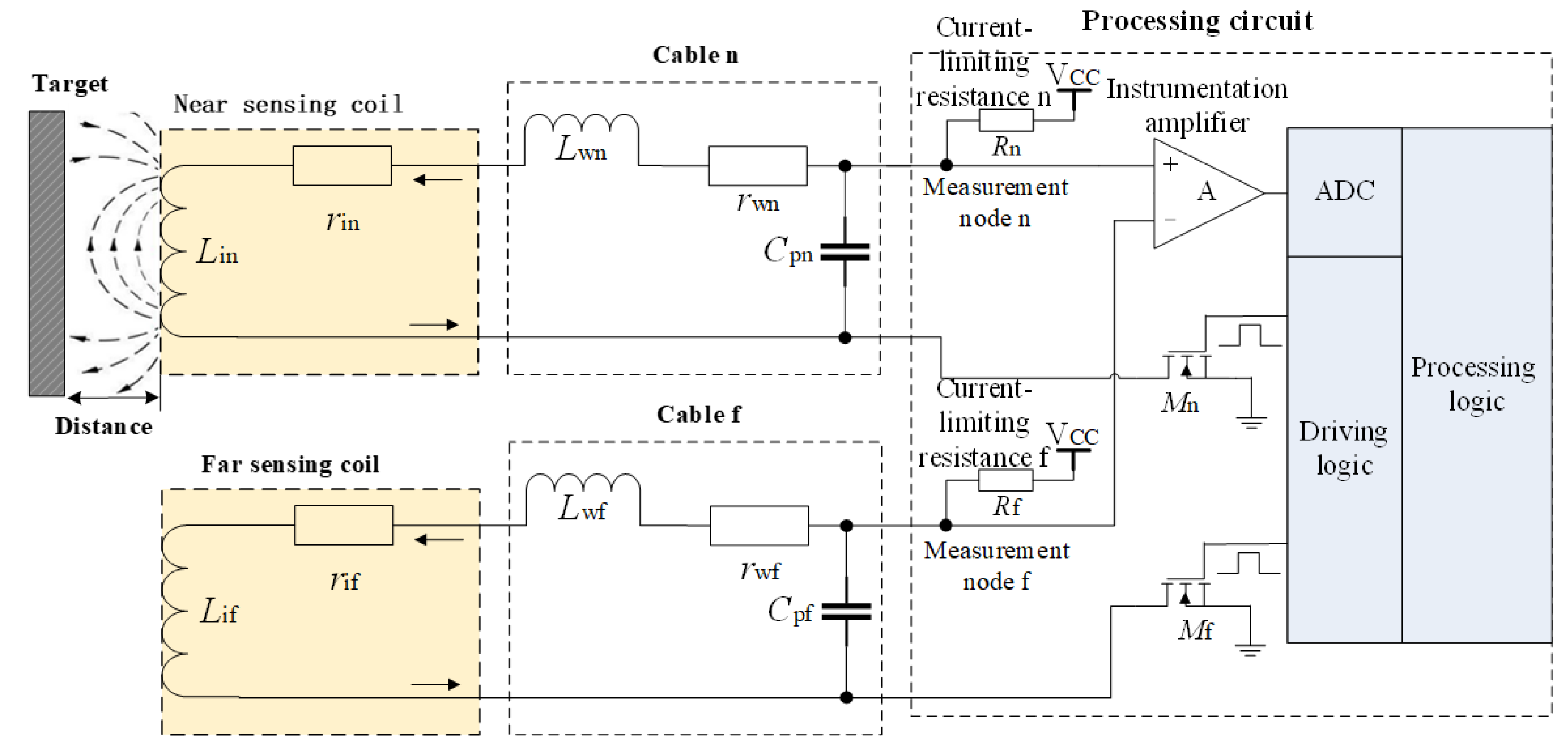

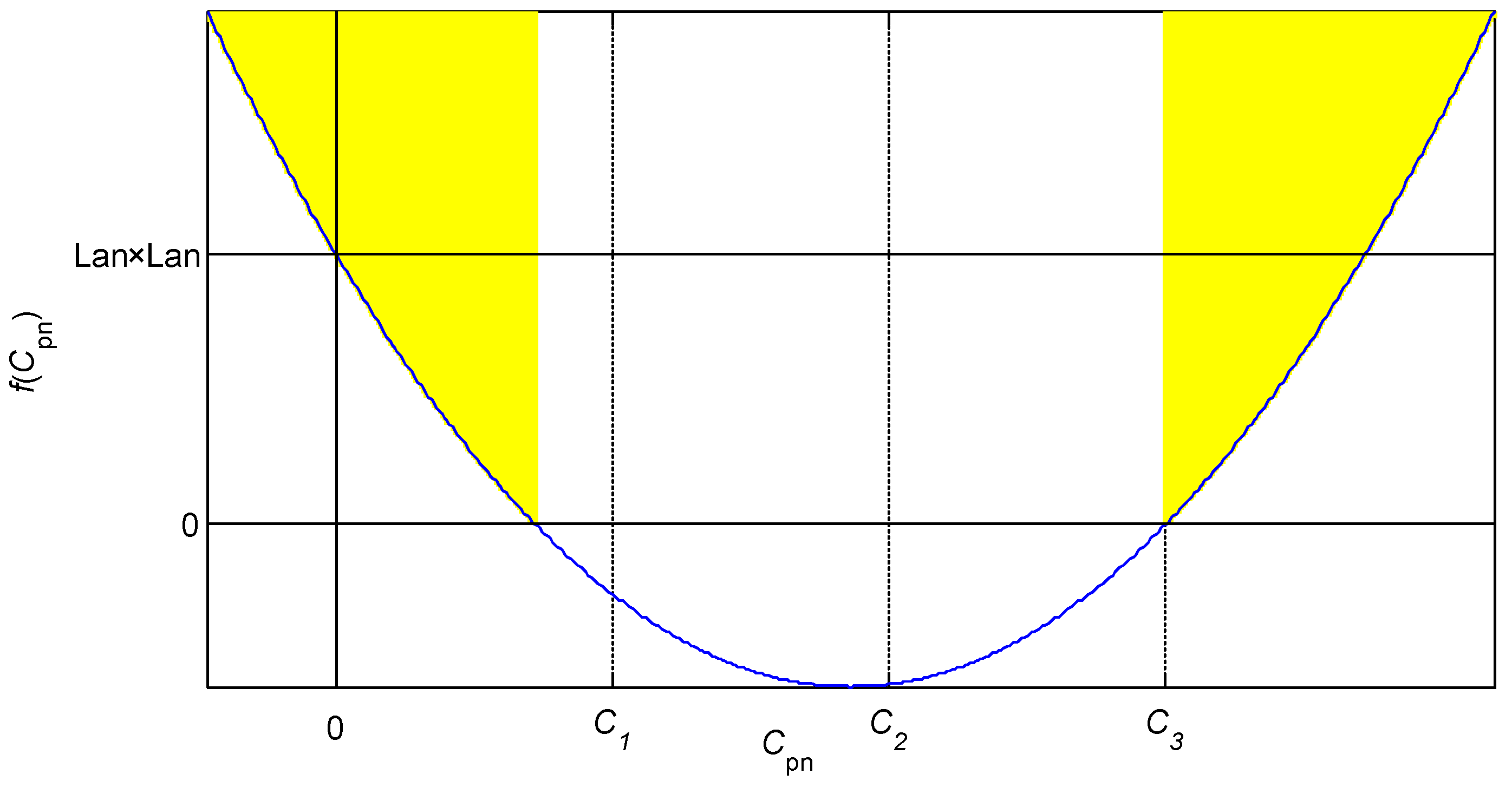

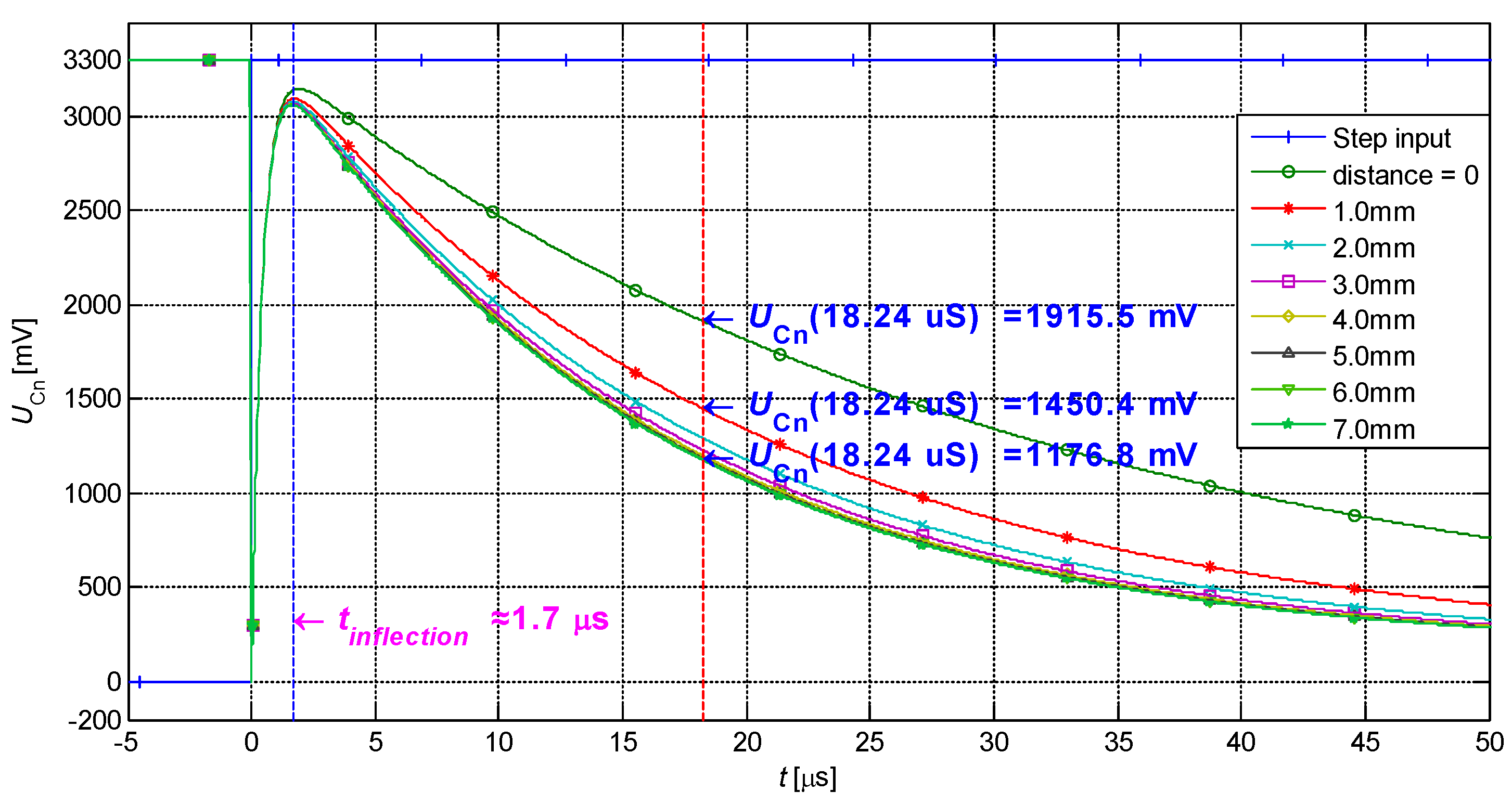
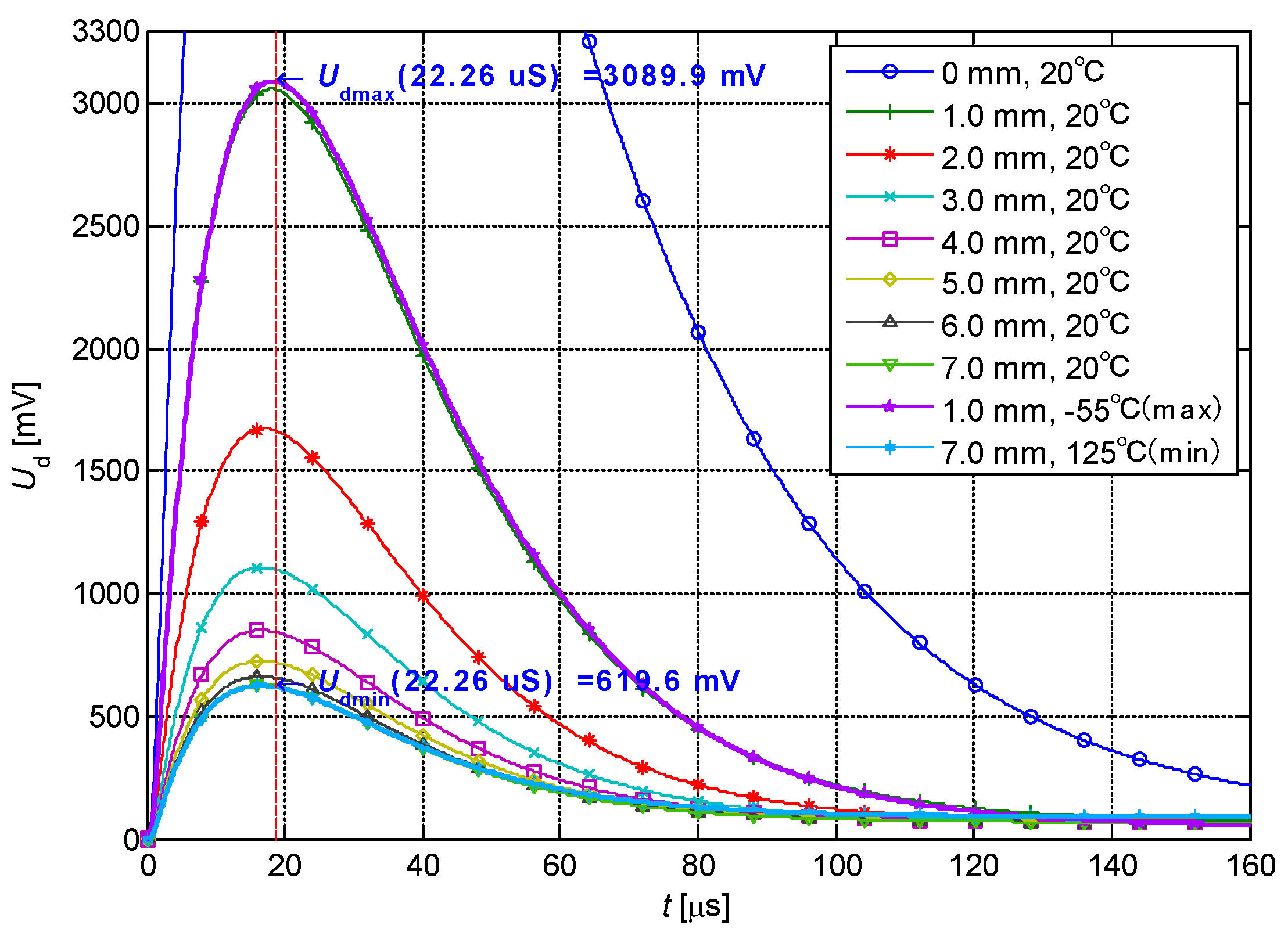

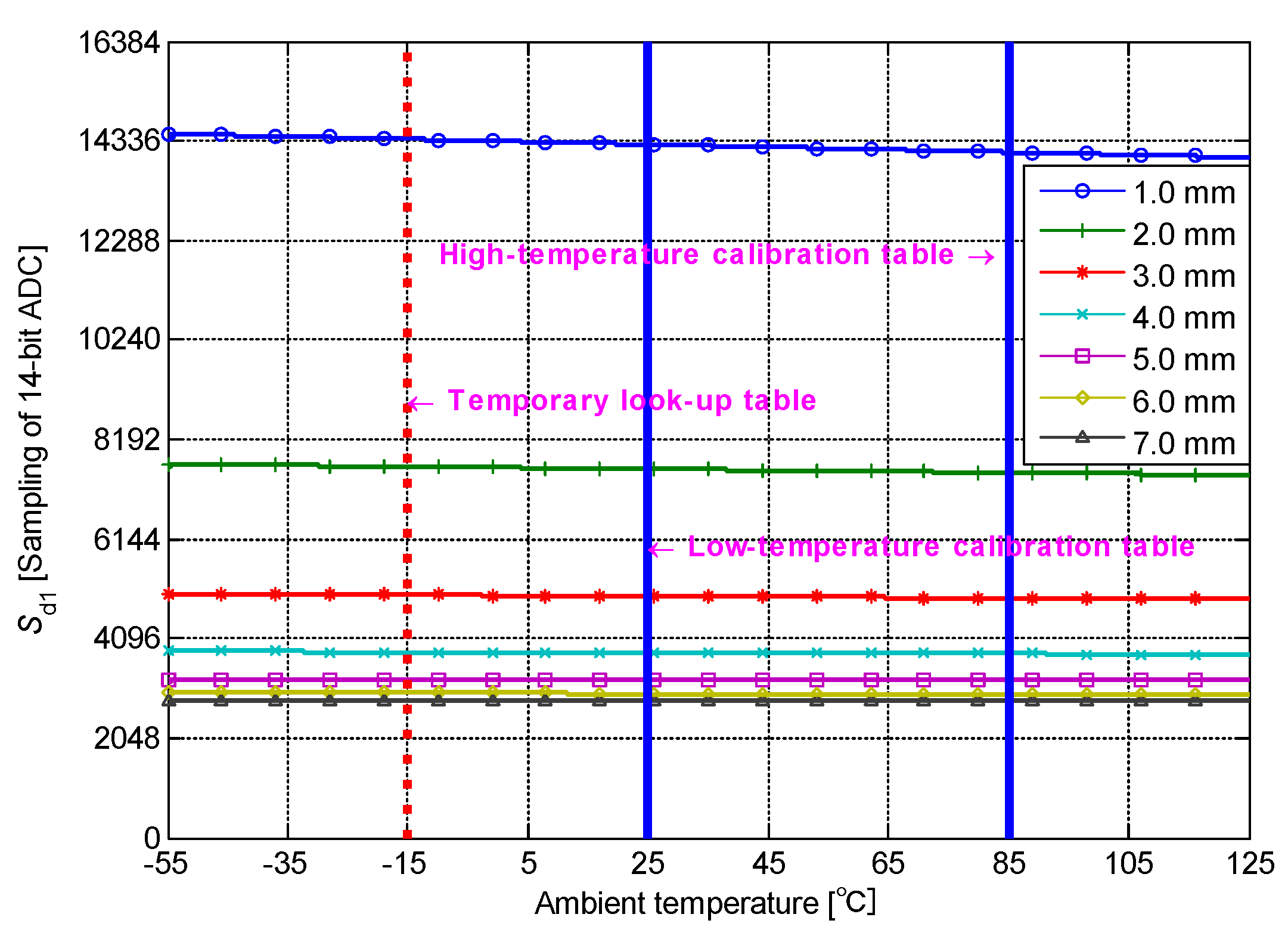

| Distance | Calibration Operator M | Calibration Operator N | Temporary Look-up Table Sd1T_i | Sample Value Sd1 |
|---|---|---|---|---|
| 1.0 mm | M0 | N0 | Sd1T_10 | Less than Sd1T_10 |
| 1.1 mm | M1 | N1 | Sd1T_11 | Less than Sd1T_11 |
| 1.2 mm | M2 | N2 | Sd1T_12 | Less than Sd1T_12 |
| … | … | … | … | Less than… |
| x × 0.1 mm | Mx | Nx | Sd1T_x | Greater than Sd1T_x |
| … | … | … | … | Greater than… |
| 7.0 mm | M70 | N70 | Sd1T_70 | Greater than Sd1T_70 |
| Distance (mm) | Sensitivity of Differential Structured IPS/Single-Coil Structured IPS (LSB/0.10 mm) | ||||||
|---|---|---|---|---|---|---|---|
| −55 °C 9.29 Ω | −25 °C 10.85 Ω | 5 °C 12.42 Ω | 35 °C 13.98 Ω | 65 °C 15.55 Ω | 95 °C 17.11 Ω | 125 °C 18.67 Ω | |
| 1.00–1.10 | 1201.4/135.5 | 1194.5/134.7 | 1187.5/133.8 | 1180.7/133.0 | 1173.8/132.2 | 1167.0/131.5 | 1160.3/130.7 |
| 2.00–2.10 | 443.2/49.4 | 440.2/49.1 | 437.2/48.7 | 434.2/48.4 | 431.2/48.0 | 428.3/47.7 | 425.4/47.4 |
| 3.00–3.10 | 184.5/20.5 | 183.2/20.3 | 181.9/20.2 | 180.5/20.0 | 179.2/19.9 | 177.9/19.8 | 176.6/19.6 |
| 4.00–4.10 | 86.4/9.6 | 85.8/9.5 | 85.2/9.4 | 84.5/9.4 | 83.9/9.3 | 83.3/9.2 | 82.6/9.2 |
| 5.00–5.10 | 41.6/4.6 | 41.3/4.6 | 41.0/4.5 | 40.6/4.5 | 40.3/4.5 | 40.0/4.4 | 39.7/4.4 |
| 6.00–6.10 | 23.3/2.6 | 23.1/2.6 | 22.9/2.5 | 22.8/2.5 | 22.6/2.5 | 22.4/2.5 | 22.2/2.5 |
| 7.00–7.10 | 11.7/1.3 | 11.6/1.3 | 11.5/1.3 | 11.4/1.3 | 11.3/1.3 | 11.2/1.2 | 11.1/1.2 |
| Distance (mm) | Interpolation Errors of Differential Structured IPS/Single-Coil Structured IPS (LSB) | ||||||
|---|---|---|---|---|---|---|---|
| −55 °C 9.29 Ω | −25 °C 10.85 Ω | 5 °C 12.42 Ω | 35 °C 13.98 Ω | 65 °C 15.55 Ω | 95 °C 17.11 Ω | 125 °C 18.67 Ω | |
| 1.00 | −7.082/1.109 | −3.401/0.534 | −0.849/0.134 | 0.575/−0.091 | 0.922/−0.146 | 0.217/−0.034 | −1.503/0.239 |
| 2.00 | −3.275/1.218 | −1.573/0.586 | −0.392/0.147 | 0.266/−0.100 | 0.426/−0.160 | 0.100/−0.038 | −0.695/0.262 |
| 3.00 | −1.705/1.256 | −0.819/0.604 | −0.204/0.151 | 0.139/−0.103 | 0.222/−0.165 | 0.052/−0.039 | −0.362/0.270 |
| 4.00 | −0.992/1.271 | −0.477/0.612 | −0.119/0.153 | 0.081/−0.104 | 0.129/−0.167 | 0.030/−0.039 | −0.211/0.274 |
| 5.00 | −0.648/1.279 | −0.312/0.615 | −0.078/0.154 | 0.053/−0.105 | 0.085/−0.168 | 0.020/−0.040 | −0.139/0.275 |
| 6.00 | −0.472/1.282 | −0.227/0.617 | −0.057/0.154 | 0.039/−0.105 | 0.062/−0.168 | 0.015/−0.040 | −0.101/0.276 |
| 7.00 | −0.378/1.284 | −0.182/0.618 | −0.045/0.155 | 0.031/−0.105 | 0.050/−0.169 | 0.012/−0.040 | −0.081/0.276 |
| Distance (mm) | Interpolation Errors of Differential Structured IPS/Single-Coil Structured IPS (μm) | ||||||
|---|---|---|---|---|---|---|---|
| −55 °C 9.29 Ω | −25 °C 10.85 Ω | 5 °C 12.42 Ω | 35 °C 13.98 Ω | 65 °C 15.55 Ω | 95 °C 17.11 Ω | 125 °C 18.67 Ω | |
| 1.00 | −0.589/0.819 | −0.285/0.397 | −0.071/0.100 | 0.049/−0.068 | 0.079/−0.110 | 0.019/−0.026 | −0.130/0.183 |
| 2.00 | −0.739/2.465 | −0.357/1.195 | −0.090/0.301 | 0.061/−0.206 | 0.099/−0.333 | 0.023/−0.079 | −0.163/0.554 |
| 3.00 | −0.924/6.127 | −0.447/2.971 | −0.112/0.749 | 0.077/−0.513 | 0.124/−0.829 | 0.029/−0.197 | −0.205/1.379 |
| 4.00 | −1.148/13.261 | −0.556/6.431 | −0.140/1.621 | 0.096/−1.110 | 0.154/−1.796 | 0.037/−0.427 | −0.256/2.986 |
| 5.00 | −1.559/27.742 | −0.755/13.455 | −0.190/3.391 | 0.130/−2.323 | 0.210/−3.757 | 0.050/−0.893 | −0.349/6.249 |
| 6.00 | −2.027/49.694 | −0.983/24.103 | −0.247/6.074 | 0.169/−4.161 | 0.274/−6.731 | 0.065/−1.600 | −0.455/11.196 |
| 7.00 | −3.240/99.376 | −1.571/48.201 | −0.396/12.148 | 0.271/−8.321 | 0.439/−13.461 | 0.104/−3.200 | −0.730/22.391 |
| Performance | Present study | Single-coil structured IPS in previous study [56] | Application-specific IC [41] | Honeywell ZS-00305 [39] |
|---|---|---|---|---|
| Temperature Drift Reduction | Self-adaptive, compensation is unnecessary | Self-adaptive, compensation is unnecessary | Customized thermal resistance compensation is required | Unknown |
| Measurement Method | Analog–digital mixed | Analog–digital mixed | Analog | Analog |
| Quantitative Output | Yes | Yes | No | No |
| Cable Adaptability | Recalibration is unnecessary | Recalibration is needed | Analog parameters need to be adjusted | Unknown |
| Response Variation in Dynamic Range | 71.2% | 7.9% | None | None |
| Measurement Sensitivity | 1201.4 LSB/0.10 mm | 135.5 LSB/0.10 mm | None | None |
| Interpolation Distance Error | −3.240 μm | 99.376 μm | None | None |
| Size of Look-up Table (units) | 122 | 142 | None | None |
| MCU or DSP | Non-adoptive | Non-adoptive | Non-adoptive | Non-adoptive |
© 2019 by the authors. Licensee MDPI, Basel, Switzerland. This article is an open access article distributed under the terms and conditions of the Creative Commons Attribution (CC BY) license (http://creativecommons.org/licenses/by/4.0/).
Share and Cite
Guo, Y.-X.; Lai, C.; Shao, Z.-B.; Xu, K.-L.; Li, T. Differential Structure of Inductive Proximity Sensor. Sensors 2019, 19, 2210. https://doi.org/10.3390/s19092210
Guo Y-X, Lai C, Shao Z-B, Xu K-L, Li T. Differential Structure of Inductive Proximity Sensor. Sensors. 2019; 19(9):2210. https://doi.org/10.3390/s19092210
Chicago/Turabian StyleGuo, Yi-Xin, Cong Lai, Zhi-Biao Shao, Kai-Liang Xu, and Ting Li. 2019. "Differential Structure of Inductive Proximity Sensor" Sensors 19, no. 9: 2210. https://doi.org/10.3390/s19092210
APA StyleGuo, Y.-X., Lai, C., Shao, Z.-B., Xu, K.-L., & Li, T. (2019). Differential Structure of Inductive Proximity Sensor. Sensors, 19(9), 2210. https://doi.org/10.3390/s19092210





